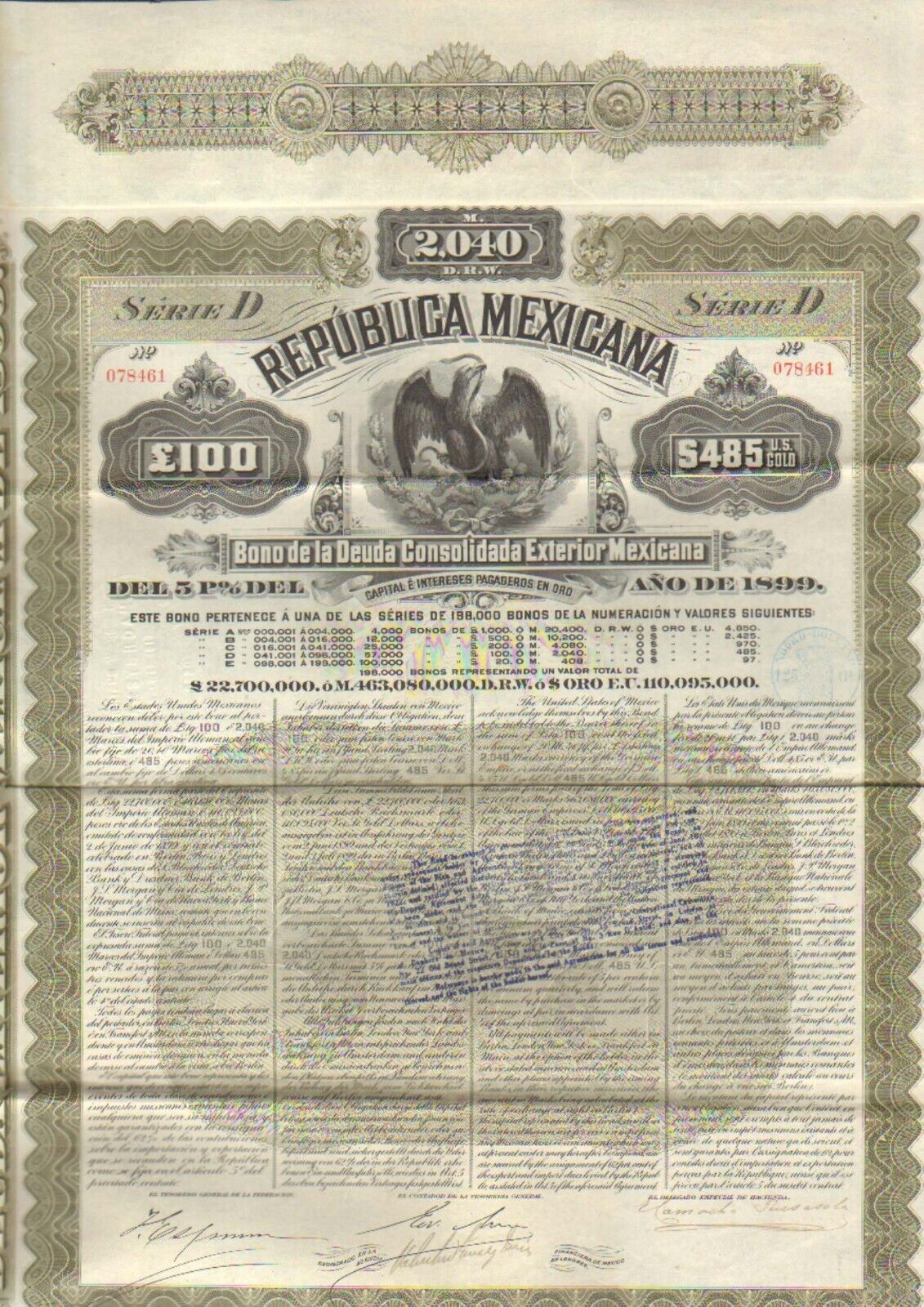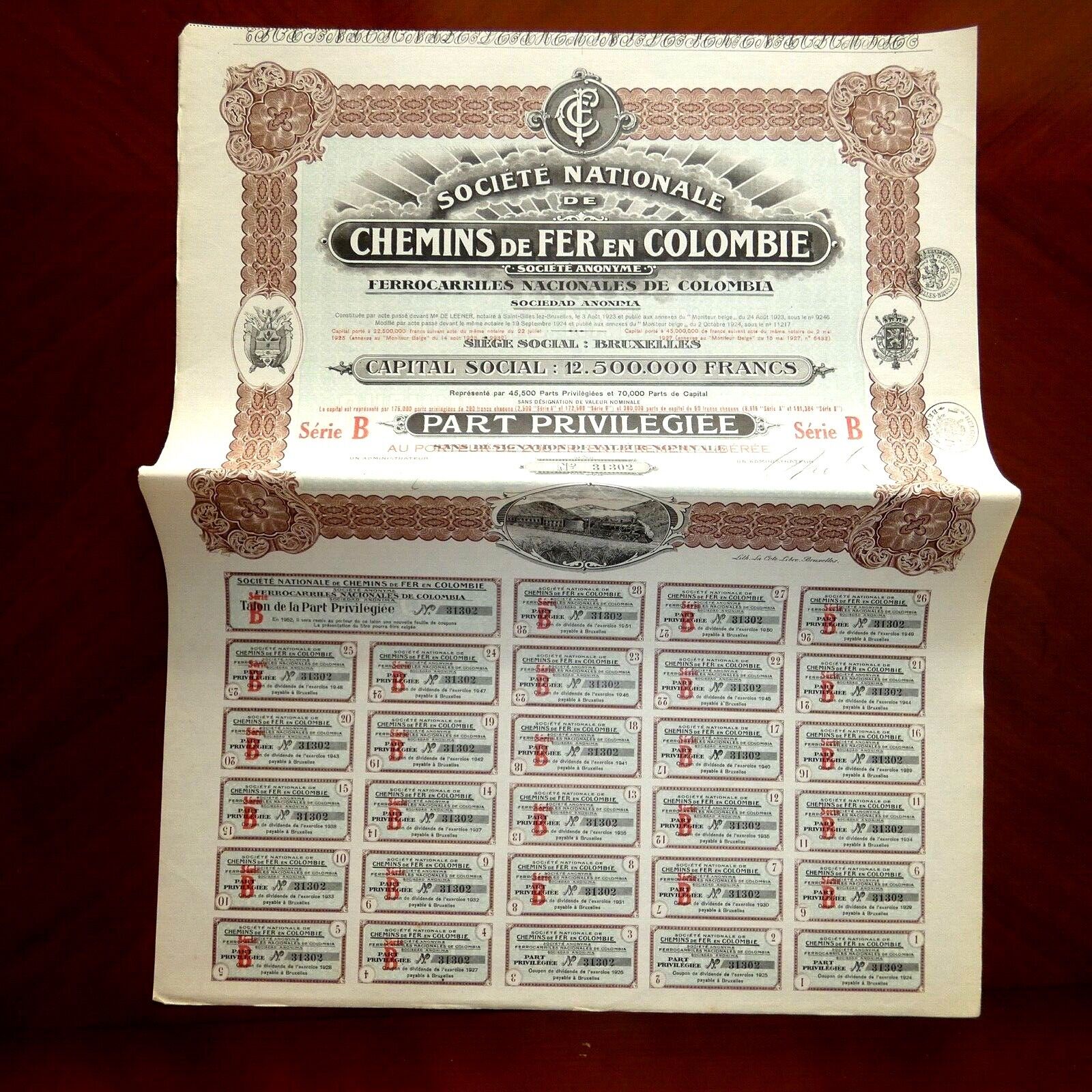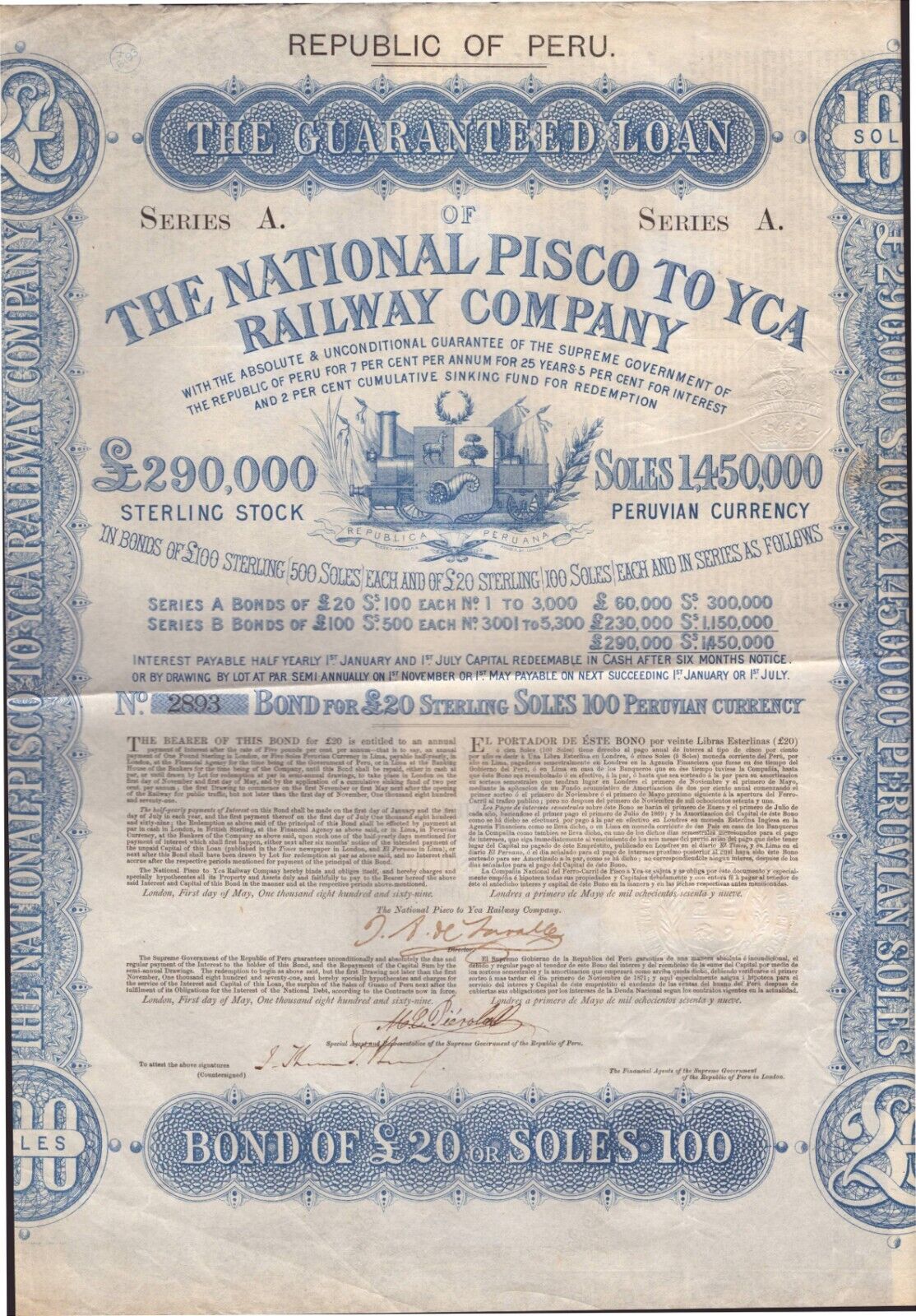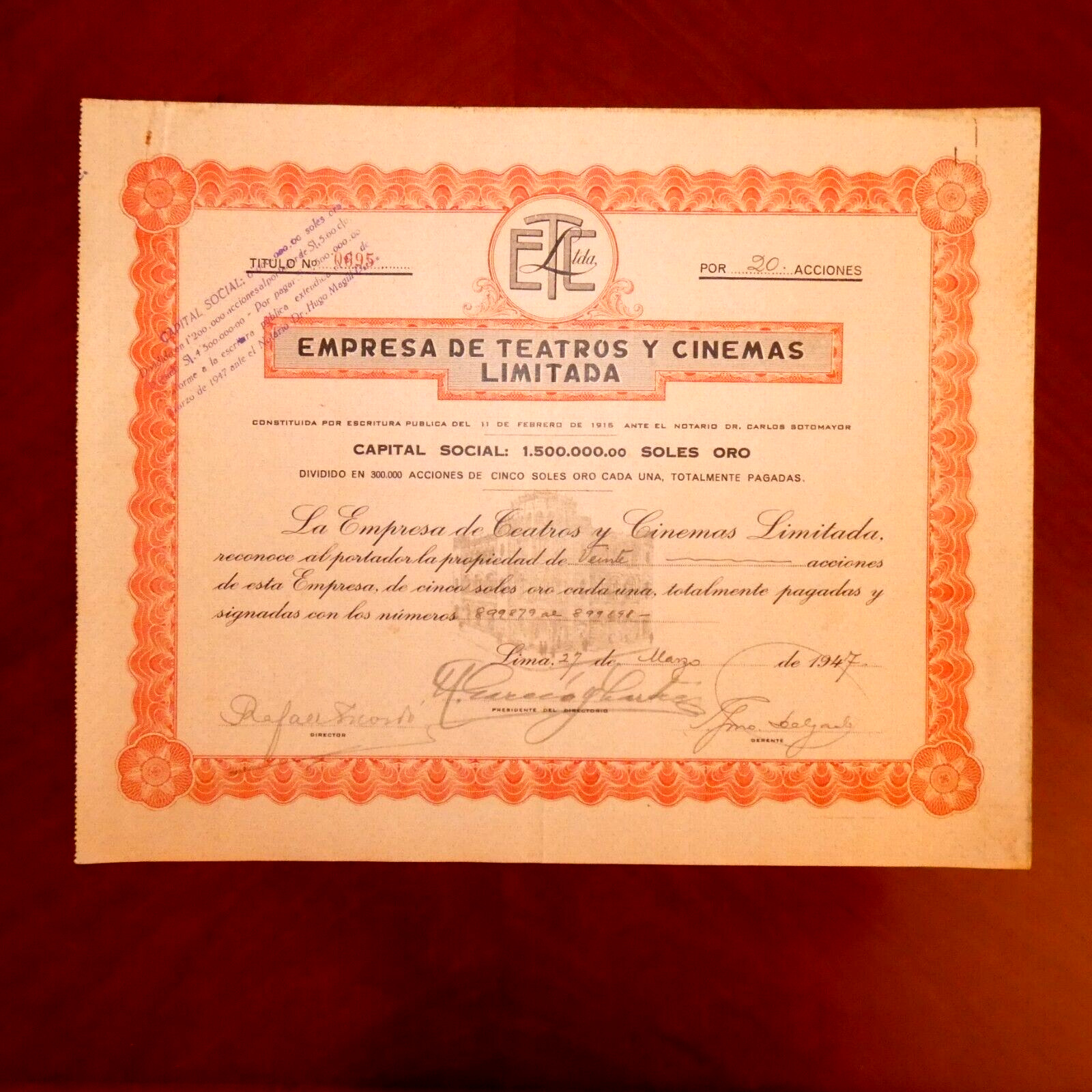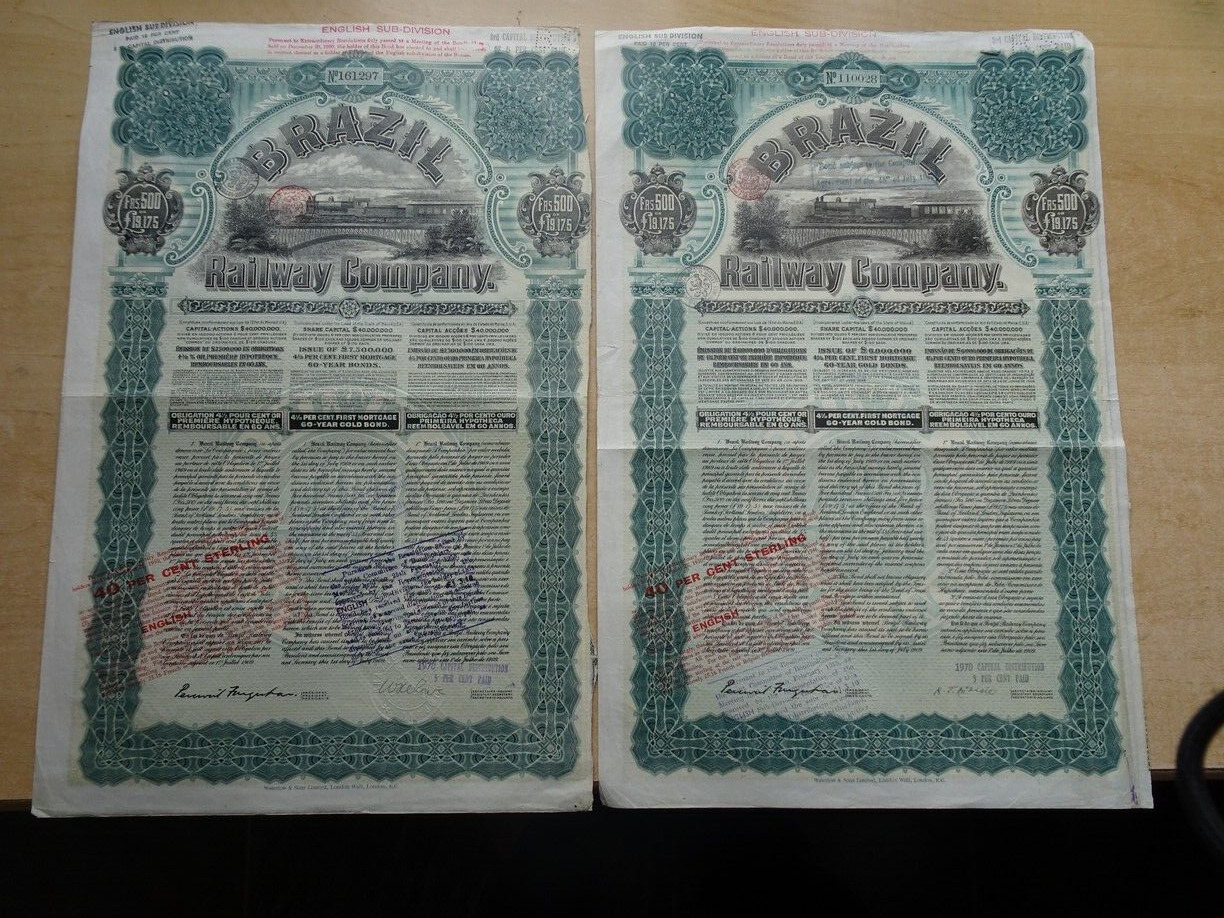-40%
Negociación Agrícola La Sauteña,share certificate Mexico 1907 VF
$ 36.96
- Description
- Size Guide
Description
One bearer share certificate of :Mexico, Negociación Agrícola La Sauteña,1907.Mexico 30 Nov 1907, certificate for one 100 Pesos share .Condition (opinion) :Very Fine.High quality printing,watermark paper. 34 coupons remain uncut.Printer:Giesecke & Devrient,Berlin.Size :29,5/46,5 cm (only the certificate),certificate with coupons :39/46,5 cm.(large)See related information below from the web.
--------------------------------------------------------------------------------------------
Postage, including packing material, handling fees : Europe: USD 6.40 / USA $ 7.30. Rest of the World: USD 8.10
FREE of postage for any other items.
Only one shipping charge per shipment (the highest one) no matter how many items you buy (combined shipping).
-----------------------------------------------------------------------------
Guaranteed genuine -
One
month
return
policy
(retail sales) .
Returns accepted with no questions.
Customers are invited to combine purchases to save postage.
Full refund policy ,including shipping cost,guaranteed in case of lost or theft after the completion of the complaint with Spanish Correos for the registered letters (purchases above $ 60.00).
As we have (or could have) more than one identical item ,the serial number may differ from those shown in the picture which is for reference only.
For purchases above .00 we send the orders registered with tracking number without extra charge, for purchases below .00 we ship as regular letters at the buyer's risk.
For purchases below $ 60,00 who want to register your letter with tracking number, please add an extra for : Europe .50 , U.S. .50 ,Rest of the word .30 .Please request or wait for our invoice before paying.
For some destinations and purchases below .00 customers may be requested for this extra shipping payment in order to register the shipment with tracking number.
We reserve the right to cancel transactions that require the sending of unregistered letters (without tracking number) to some destinations, when this extra payment has been requested.
If for any reason, your item did not arrive yet, or you are not 100% satisfied with the item you have received, please do not hesitate to contact , I will do all it takes to provide the best service.
Banknote Grading
UNC
AU
EF
VF
F
VG
G
Fair
Poor
Uncirculated
About Uncirculated
Extremely Fine
Very Fine
Fine
Very Good
Good
Fair
Poor
Edges
no counting marks
light counting folds OR...
light counting folds
corners are not fully rounded
much handling on edges
rounded edges
Folds
no folds
...OR one light fold through center
max. three light folds or one strong crease
several horizontal and vertical folds
many folds and creases
Paper
color
paper is clean with bright colors
paper may have minimal dirt or some color smudging, but still crisp
paper is not excessively dirty, but may have some softness
paper may be dirty, discolored or stained
very dirty, discolored and with some writing
very dirty, discolorated, with writing and some obscured portions
very dirty, discolored, with writing and obscured portions
Tears
no tears
no tears into the border
minor tears in the border, but out of design
tears into the design
Holes
no holes
no center hole, but staple hole usual
center hole and staple hole
Integrity
no pieces missing
no large pieces missing
piece missing
piece missing or tape holding pieces together
----------
See below information from the web:
Born in Spain in 1853,
Iñigo Noriega Laso
immigrated to Mexico in 1867. Through a series of partnerships over the next thirty years he developed one of the most impressive business and industrial networks in Mexico, with an estimated value of forty million pesos in 1910. His interests included the vast agricultural enterprises of Xico in Mexico State and Colombres/Río Bravo and
La Sauteña
in Tamaulipas; factories producing turpentine and resin (Río Bravo), textiles (Compañía Industrial La Guadalupe); tobacco (La Mexicana); mining (Compañía Minera Tlalchichilpa); railroads (Ferrocarril Río Frío and Hidalgo); and land development projects such as the draining of the Lago de Chalco. His
La Sauteña
projects included irrigation, rail, and port development and colonization.
p
>
<
p
>
Noriega’s business network in Mexico began when he formed a partnership with his brother, Remigio, in 1881. Through this partnership, Remigio Noriega y Hermano, the Noriega brothers created various companies and acquired extensive property in northern Mexico before the partnership dissolved in 1898. Among these companies were the Compañía Minera y Beneficiadora de Metales de Tlalchichilpa y Anexas,
Compañía Agrícola La Sauteña
in 1888, and Negociación Agrícola de Xico y Anexas in 1897. La
Compañía Agrícola La Sauteña
, which comprised the municipality of Matamoros, a large portion of Reynosa, and part of San Fernando and Mendez, split into two entities in 1912:
Compañía Agrícola La Sauteña
and Compañía Agrícola de Colombres. The split allowed Noriega to complete various irrigation projects. Compañía Agrícola de Colombres was later renamed Compañía Agrícola de Rio Bravo.
p
>
<
p
>
Due to his close ties with Porfirio Díaz, Noriega fled Mexico in 1913 during the Mexican Revolution. The Zapatistas took possession of the mine operated by the Compañía Minera Tlalchichilpa where Emiliano Zapata had once worked, as well as Xico, Río Frío, and the Hacienda de Zoquiapam, exploiting the properties and appropriating the revenues and assets for themselves. The Carranzistas also forcibly occupied parts of La Sauteña, Río Bravo, and the textile mill of the Compañía Industrial La Guadalupe. Noriega’s family and associates continued to manage his other businesses while Noriega spent considerable energy seeking to recuperate his confiscated properties after the Revolution ended.
p
>
<
p
>
Noriega died December 4, 1920 in Mexico. [The Library of Congress authority file lists Noriega’s date of death as 1923.]
Biographical Note
Born in Spain in 1853, Iñigo Noriega Laso immigrated to Mexico in 1867. Through a series of partnerships over the next thirty years he developed one of the most impressive business and industrial networks in Mexico, with an estimated value of forty million pesos in 1910. His interests included the vast agricultural enterprises of Xico in Mexico State and Colombres/Río Bravo and La Sauteña in Tamaulipas; factories producing turpentine and resin (Río Bravo), textiles (Compañía Industrial La Guadalupe); tobacco (La Mexicana); mining (Compañía Minera Tlalchichilpa); railroads (Ferrocarril Río Frío and Hidalgo); and land development projects such as the draining of the Lago de Chalco. His La Sauteña projects included irrigation, rail, and port development and colonization.
Noriega’s business network in Mexico began when he formed a partnership with his brother, Remigio, in 1881. Through this partnership, Remigio Noriega y Hermano, the Noriega brothers created various companies and acquired extensive property in northern Mexico before the partnership dissolved in 1898. Among these companies were the Compañía Minera y Beneficiadora de Metales de Tlalchichilpa y Anexas, Compañía Agrícola La Sauteña in 1888, and Negociación Agrícola de Xico y Anexas in 1897. La Compañía Agrícola La Sauteña, which comprised the municipality of Matamoros, a large portion of Reynosa, and part of San Fernando and Mendez, split into two entities in 1912: Compañía Agrícola La Sauteña and Compañía Agrícola de Colombres. The split allowed Noriega to complete various irrigation projects. Compañía Agrícola de Colombres was later renamed Compañía Agrícola de Rio Bravo.
Due to his close ties with Porfirio Díaz, Noriega fled Mexico in 1913 during the Mexican Revolution. The Zapatistas took possession of the mine operated by the Compañía Minera Tlalchichilpa where Emiliano Zapata had once worked, as well as Xico, Río Frío, and the Hacienda de Zoquiapam, exploiting the properties and appropriating the revenues and assets for themselves. The Carranzistas also forcibly occupied parts of La Sauteña, Río Bravo, and the textile mill of the Compañía Industrial La Guadalupe. Noriega’s family and associates continued to manage his other businesses while Noriega spent considerable energy seeking to recuperate his confiscated properties after the Revolution ended.
Noriega died December 4, 1920 in Mexico. [The Library of Congress authority file lists Noriega’s date of death as 1923.]
------------------------------------------------
Your browser does not support JavaScript. To view this page, enable JavaScript if it is disabled or upgrade your browser.







